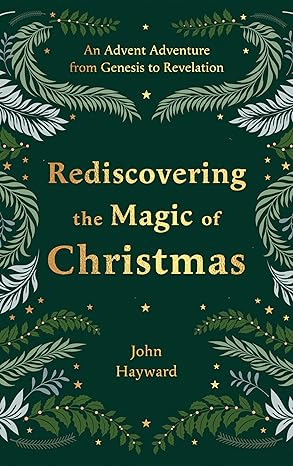Rediscovering the magic of Christmas
We can find a fresh perspective on the nativity story by considering some of the less familiar texts that point to and talk about the birth of the Saviour, writes John Hayward
 About ten years ago, a survey showed that among both children and parents who had read, seen or heard Bible stories, the nativity was their favourite. What’s more, around one-in-three adults reportedly have an Advent calendar.
About ten years ago, a survey showed that among both children and parents who had read, seen or heard Bible stories, the nativity was their favourite. What’s more, around one-in-three adults reportedly have an Advent calendar.
However, more than half of people also tell pollsters that “the birth of Jesus is irrelevant to my Christmas.” Around one-in-six even indicate that they “dread Christmas”.
Yet, the story of Christmas should continue to cause us to wonder. It should remain a marvel that the infinite, eternally existent Creator of time and space chose to be confined and contained within the finite ‘tent’ of a human body bound by space and time!It should continue to fill us with awe that God identified himself with us, sharing in our humanity, in order that whoever identifies themselves with Christ might share in his righteousness, everlasting life and relationship with our heavenly Father!
If we want to rediscover some of the magic and mystery of Christmas, perhaps we need to seek a fresh perspective on the nativity story. Rather than heading straight for the obvious scripture readings—such as the prophecy of Isaiah 9, the angels of Luke 2 or the opening verses of John 1—perhaps we should consider some of the less familiar texts that point to and talk about the birth of the Saviour. After all, it is rightly said that every passage in the Old and New Testaments “predicts, prepares for, reflects, or results from the person and/or work of Christ.” Even Jesus affirmed that the Scriptures bear witness about him (e.g. John 5:39).
In Rediscovering the Magic of Christmas, that is effectively what I seek to undertake. Originally compiled as a series of daily Advent reflections for the benefit of my adult children, both then at university, my aim was to peel away the many layers of tradition and bring a fresh perspective to the nativity.
I wanted to unwrap something of the bigger story that appears as the description of Christ’s coming is gradually revealed from Genesis to the Gospels and on to Revelation. In doing so, I hoped to explore some of the passages less frequently read each December and to consider some of the traditional texts from a fresh angle.
The more I delved into this unfolding narrative, the more excited I became. Rediscovering the Magic of Christmas attempts to capture and share some of that thrill and sense of adventure.
For instance, if our nativity scenes include Matthew’s magi and Luke’s shepherds, why not also John’s dragon, from Revelation 12? Subconsciously, perhaps we resist this idea because we are uncomfortable with “that ancient serpent” reminding us of the reason why Jesus had to be born—namely, the Fall—and of our daily and, without Christ, lifelong unsuccessful struggle with sin and death.
Yet its inclusion should instead encourage us greatly. For it also reminds us that “God sent his Son, born of a woman, born under the law, to redeem those under the law, that we might receive adoption to sonship” (Galatians 4:4–5). It reminds us that “Christ redeemed us from the curse of the law by becoming a curse for us … so that in Christ Jesus the blessing of Abraham might come to the Gentiles, so that we might receive the promised Spirit through faith” (Galatians 3:13–14).
For me, one of the insights that most stood out afresh was how the interlocking themes of justice and judgment are intrinsically bound up with the mission and purpose of the Messiah—and how we, the community of God’s people, are called to share in that same mission through our lives together, participating in his sufferings so as to attain to the resurrection from the dead (Philippians 3:10–11).
I also loved exploring in greater detail the link between God’s creation and incarnation—and its implications. In the words of a former bishop of Lincoln, Robert Grosseteste, the incarnation was the “final act in the unfolding drama of creation: it made Man and Nature complete, and it bound the whole created universe together in union with God.”
Christ’s coming showed us how and what it means to be fully human. It gives us assurance that, with his second coming, “creation itself will be liberated from the bondage of corruption and brought into the freedom of the glory of the children of God” (Romans 8:21).
Some readers will want to read the daily devotions alongside their Bible. Others will just want to read the “Quick version” paragraphs and skip to the “Pause to ponder” questions. Either way, my hope for the book is that it enables every reader to rediscover something of the excitement and wonder of Christmas that we might all the more eagerly anticipate Christ’s return.
For, to borrow the words of Richard Dawkins, ‘The truth is more magical – in the best and most exciting sense of the word – than any myth or made-up mystery or miracle.’
John has been an active member of Eden Baptist Church, Cambridge, since the early 1990s.
Throughout his career, he has promoted freedom, strengthened democracy and empowered disadvantaged communities. This has included cross-cultural work in Central Asia, directing the Jubilee Centre in the UK, delivering training across Africa, and teaching in churches and Christian universities in the UK and the USA.
A lifelong writer – from foreign-language textbooks to newspaper op-eds and UK policy reports – Rediscovering the magic of Christmas (SPCK) is his first devotional book. It is part of the 2024 Big Church Read.
Do you have a view? Share your thoughts via our letters' page.
Baptist Times, 14/11/2024